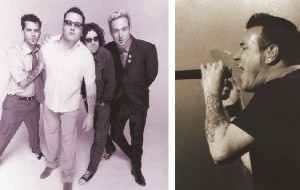
Smash
Mouth
SMASH
Mouth (named after Mike Ditka's term "smash mouth football")
was formed in San Jose, Calif., in 1994 when boyhood friends and former
band compadres Steve Harwell (vocals) and Kevin Coleman (drums) recruited
Greg Camp (guitar) from a local cover band. Camp then persuaded Paul
De Lisle (bass), with whom he'd played in another outfit, to take
a chance on the new band.
After toiling
for a couple of years on the San Jose scene, Smash Mouth caught fire
when area radio station KOME started spinning what would be their
breakthrough: "Nervous In The Alley" (Smash Mouth were the
first unsigned band to receive regular rotation on the influential
Modem Rock outlet). Soon thereafter, the quartet inked a deal with
Interscope Records, which released their debut, Fush Yu Mang, in 1997.
Smash Mouth supported
the album with extensive touring, including jaunts with Sugar Ray,
Third Eye Blind and Blur, among others. Buoyed by these road efforts,
the #1 radio success of "Walkin' On The Sun" and a cover
of War's "Why Can't We Be Friends" (not to mention a couple
of heavily rotated videos), Fush Yu... bum-rushed the Top 20 and racked
up double platinum sales.
The
band built on their success with a rendition of? and the Mysterians'
"Can't Get Enough of You Baby," which made its debut on
the soundtrack to "Can't Hardly Wait." The cut is also included
on Smash Mouth's latest opus, Astro Lounge.

Produced by Eric
Valentine, who sat behind the boards for Fush Yu..., Astro Lounge
was introduced by the radio track "All Star," which began
rocketing up Modern Rock charts in May of 1999 (it entered the Top
5 of Billboard's Modern Rock Tracks before the month was out). "All
Star" was also slated to be the first single and video from the
soundtrack to "The Mystery Men."
Says
principal songwriter Greg Camp of the tune that seemed likely to make
Smash Mouth superstars: "That's sort of our 'Everybody is a Star.'
It basically says, 'Don't get down on yourself - with a little bit
of spring in your stride, you can do whatever you want.'" Camp
is also quick to expound on another Astro Lounge standout, the more
pointed "Radio." "It's kind of about our love/hate
relationship with radio and the people who have power over it,"
he confides. "They can really stomp on you if they don't like
you. They love you when you're on top - they all want to talk to you.
But when you're not... It's something we didn't realize until "Walkin'on
the Sun" started dying down and we got called 'one-hit wonders'.
We don't take ourselves totally seriously, but we do want people to
know we actually work really hard at doing this, and sometimes the
ups and downs can be tough to roll with."
s
u n b e a m
A
Promising Name On The Bangladesh Pop Scene
By
Tishma
Effervescent,
impulsive, and armed with a pleasantly ingenuous air of charmingly
unbridled amiability, Sunbeam, with his inherently sunny demeanour
and innate candour, is refreshingly untarnished, at least if mere
surface appearances are to be relied on, by the been-there-done-that,
jaded quality that tends to saturate the disposition of most new-kid-on-the-block,
just-hit-the-big-time-recently artists experiencing their first taste
of stardom.
While Pahela
Baishakh this year (or, 14th April 2003) may have witnessed the launch
of Ekla Prohor, the Sunbeam's debut solo effort, the promising artist
has actually been toying with taking tentative steps on the scene
for quite a while already. It may come as a surprise that Sunbeam
has recorded about sixty songs to date, out of which about thirty-two
songs have been released on albums. His debut recording first saw
the light of day in 1999, in the 'mixed' (compilation) album 'Dekha
Hobe Bondhu'. Since then, there has been no looking back for the artiste.
He followed up by contributing to a whopping eight further mixed albums,
namely Maya (2000), Shimato Biswas Koro (2000), Bawanno Bajar Teppann
Goli (2001), Bojhini Kadabe (2001), Star Plus (2001), Dekha Hobe Dujone
(2002), Bondhu Re (2002), Harano Biggopti (2002), and presumably his
most massive hit yet, Chumki Choleche Eka (2003).
By the time Sunbeam's
first album hit the shelves on 14th April 2003, Pahela Baishakh (Bengali
New Year's), he had already achieved the position of having become
a fairly familiar face, if not yet an established household name,
among listeners. Sunbeam personally affirms, 'The results for my debut
solo album were outstandingly satisfactory. The response was beyond
my expectations. And I have to admit that there are very few or may
be none who gets as much support from the media as I did.'
Besides vocalising,
Sunbeam is a self-taught acoustic guitarist. 'I love to compose, write
and sing songs created by myself,' he declares with his enthusiasm
manifest. His favourite musical activity is composing tunes.
'My mother used
to sing,' recounts Sunbeam, narrating the details of his journey into
the world of music. 'I too was born with that gift. Initially I was
just another music-lover who appreciated good music. I also participated
in the usual school and college events, but I never thought that I
would come this far. I was partly involved in some local bands… nothing
worth mentioning. After college I came to Dhaka for graduation in
the year 1995, and I came to meet some people that one could only
dream of ever encountering. At first I was an ordinary fan of Jewel
Bhai. But after I met him, things got better and we became more like
a family, he has been a brother to me. Through him I met Bappa Majumder
and his family. I gradually became a part of that family. I learnt
a lot from my parents Mr. And Mrs. Barin Majumder, and my brothers
Bappa and Partho Majumder; they all play a major role behind my success,'
he reminisces affectionately, fondly referring to the family as his
own blood-related kin.
'For
my solo album, it was definitely not an easy job for me to arrange
everything by myself,' he discloses, expounding on his experiences
while recording his first solo effort. 'It took me four years to get
this job done and finally have it released. It wouldn't have taken
this long, but the reason it did is because the production companies
wouldn't release my kind of songs. It took me a while to blend into
the kind of music the production companies desired. But in the end
I have managed to stick with my taste of music and yet have the album
released with the commercial touch the company wanted.' He relates
further, 'The first few songs of my career were initially intended
to be released in my solo album, but unfortunately they have been
released in the mixed albums "Dekha Hobe Bondhu" and "Star
Plus". The songs were "Tumi Nei" for the album, "Dekha
Hobe Bondhu", and "Obishwas Koro Na Amai" for the album,
"Star Plus".'

'In our country
for a solo artist, there is a tendency to get stuck to a certain category,
to get stereotyped; the artist is not responsible for that, the surroundings
are…For that reason, I decided to start with every possible way I
could make a move on. In my solo album, there is folk, rock, soft
rock, semi-classical music as well as techno. Most of the lyrics were
meant to be contemplative and rather story-based, each with an individual
background that made each song a distinctive one with its own particular
identity. It required a lot of effort and time… In my album I have
used a lot of acoustic instruments besides synthesised-based compositions.
The song on the album appreciated the most highly by listeners is
"Hridoi Kede Jai"- the semi-classical one.'
The very first
of his musical influences that Sunbeam lists, very emphatically, is
none other than his mother. 'She is the one who has always encouraged
me to do my music, in every step of my life. Ayub Bacchu is one person
who has made me feel that this is all that I would ever want to be.'
Sunbeam holds his opportunity of having performed with LRB at the
band's 12th Anniversary celebrations in high esteem. 'It was a matter
of great honour for me to have participated in that particular concert,
singing Shesh Chithi, one of the most popular songs in this country,'
he elucidates.
'What I enjoy
the most about my career as a singer is my music, appreciation of
fans and most of all being a public figure. And an awesome feeling
is what I get when I see renowned musicians and singers humming my
songs. I love my fans. No matter however you put it, my achievement
lies right in the listeners' appreciation. The respect I have gained
through my music is my major achievement.'
When asked to
describe any engaging post-stardom anecdotes, Sunbeam comments, 'There
are many… Before my singing career I was treated like a normal guy
in the neighbourhood, but over the last four years I have been hearing
nice and interesting comments from people - like all of a sudden my
"eyes" got more attractive to people!!! And not to mention
other features! (Laughs). Now this is something that is really, really
interesting to me!'
And in response
to inquiries regarding any major difficulties or obstacles faced by
him as an artist, he reacts, 'As I mentioned earlier it wasn't an
easy job, from any perspective. Nowadays anyone with money can be
a singer, but I wanted to be an artist, so it wasn't that easy.'
'I like to travel, read books, listen to music', says Sunbeam, elaborating
on his hobbies. 'Basically I listen to almost everything, but I especially
like rock. I also have this thing for Indian classic music; the matter
would seem contradictory to many, but that's my personal taste. I
like to swim just anywhere… I like to meet new people and make new
friends. Although I don't get that much time to spend with my family,
I definitely do love to do so. As for my academics, I have completed
my MBA from AIUB, majoring in Marketing. Inshallah, I would be involved
in some other profession other than music pretty soon, too. For me
music is not a profession, it is my passion. I was being myself so
far, so singing was just being me. I sing for myself, and so I will
until I feel otherwise.'
He advises hopeful,
aspiring musicians, 'There is no alternate to practice; practice makes
a man perfect. If there is a particular type of music, then don't
just try to ignore other types, try to learn to appreciate them, because
every type of music make it a whole.' As for the people whose support,
inspiration or contributions Sunbeam would like to acknowledge: 'I
would like to thank MY MOTHER, Ayub Bacchu, Ibrar Tipu, Hasan Abid
Jewel, Izaz Khan Swapon, Shafiq Tuhin, Bappa Majumdar and others…'
With
an Indian-classical-style-honed voice that shines particularly resplendently
on Ghazal-related tracks, such as, for instance, on the delightful
track, Karo Karo Chok Theke, a song Sunbeam wrote and composed himself,
Sunbeam's evident high confidence in his abilities and admirable quantity
of faith in himself is well justified. This, coupled with his indefatigable,
persevering attitude, steely-nerved determination, and ardent passion
for music, leaves Sunbeam in possession of the formidable combination
whose assistance it takes to join the ranks of the more seasoned artists
he has learnt to admire so.
Torn 2.0
The
1982 film Tron may not hold up by today's standards, but it was a
revelation for anyone who grew up during the video game boom of the
early '80s. The movie was filled with vivid computer-generated graphics,
and it put the lead character first in a real arcade and then in neon-lit
cyberspace, where anthropomorphic "programs" faced off in
video-game-style challenges. For young gamers, at the time, watching
Tron was like dying and going to cinematic heaven. Tron gave birth
to some fun games back in the day, and now Monolith brings you Tron
2.0 for the PC.
Tron
2.0 treads a fine line between cool and corny, and, also like the
film, it often stumbles into the latter. Like the movie, the game
also boasts a unique visual style. It is a fairly conventional and
uneven shooter.
Tron
2.0 picks up where the film left off. After years of research, programmer
Alan Bradley has finally managed to re-create the technology needed
to digitize humans and send them into and out of the digital/virtual
world. A big, bad corporate rival, Future Control Industries (or fCon)
is after Bradley's research and is about to take over his company.
When Bradley's AI creation, Ma3a, comes under attack and Bradley suddenly
disappears, his son Jet must save the day. After Jet is conveniently
digitized, it's off to the races in a thematic and visual retread
of the film: Basically, red security programs menace Jet, lots of
deadly discs get thrown about, a sexy female program helps our hero
escape from the light cycle grid, and so on.
While
staying true to the film, Monolith has ably fleshed out the world
of Tron with new allies and enemies. Things are a little more complex
than in the movie since there are multiple enemy factions to deal
with now. You'll face off against the Intrusion Countermeasure Programs,
or ICPs, who are like the red guards of the film. These ICPs aren't
particularly bright or deadly, but they usually have numbers on their
side. They're under the command of the militant program "Kernel".
You'll also have to deal with finders, little sentinels that float
around high-security areas and blast you with energy bolts.
Along
with these security programs, you'll also have to face a whole other
faction of enemies. They are led by the malevolent Thorne, who secretly
sold the digitization technology to rival fCon and now acts as head
of security for Bradley's company. To prove that the technology actually
worked, he tried to digitize himself into the virtual world, but things
went awry; he ended up corrupting his data and turning mad. Now a
blight of data corruption cascades through the computer world, giving
rise to enemies like the Z-lots and rector scripts.
While
all these enemies sound diverse and interesting on paper, they leave
something to be desired in practice. That's because, at heart, Tron
2.0 is a standard run-and-gun shooter with a neon patina. These strange-sounding
digital enemies aren't really strange but turn out to be generic cannon
fodder..
The
famous glowing, Frisbee-style disc weapon from the movie reappears
in a slightly different guise, but it's one of the game's surprising
letdowns. It flies and returns to your hands so quickly that it feels
more like some fancy machine gun than a specialized, graceful weapon.
The
game features light RPG elements, so instead of leveling up, you "upgrade"
your character by completing missions and picking up "build notes"
that are scattered about the gameworld. You upgrade to version 2.0.0
and get to distribute extra stat points to a handful of abilities
like "transfer_rate" (how fast you can pick up keys, power-ups,
and the like). As the game progresses, you find, keep, and then upgrade
a variety of subroutine power-ups. When installed, these grant you
special abilities, like added damage, quieter movement, or higher
jumping. You only get a limited number of free "memory blocks,"
so you need to decide which subroutines to install at any given time.
